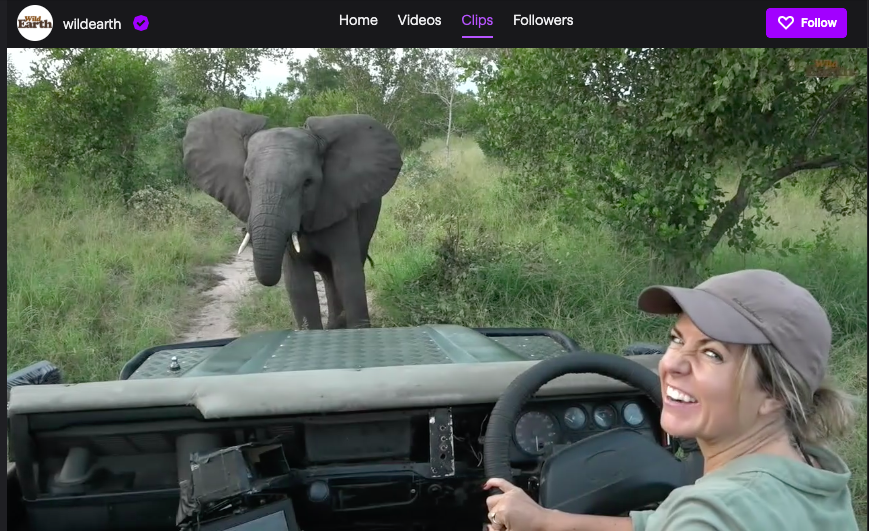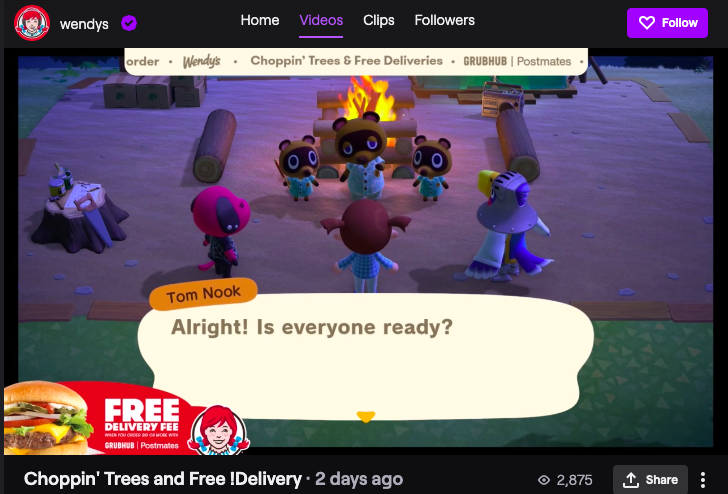I am an avid player of The Sims video games.
For over a decade, I’ve been a dedicated fan, buying each new release and playing them over and over again. Eventually, my interest in the simulation game led me to find a community of others who feel the same way.
So, I started watching YouTube videos of people playing the Sims. Most of the YouTubers promoted their Twitch accounts, where they would broadcast live play-throughs. I didn’t pay attention to Twitch at first, but eventually, curiosity got the best of me and I decided to check it out one day.
Warning: Twitch can get highly addicting.
The first time I tried Twitch, I was on the platform for three hours, exploring the content of my favorite YouTubers and chatting with others, like in the screenshot below:

The streaming platform gave me a larger community to connect with because of the chat section in each broadcast, where users can comment on the content they’re seeing. The streamer can also interact with them, making the experience feel more natural.
But, other than a streaming platform, what exactly is Twitch? In this post, we’ll explore what twitch is, and how you might use it to engage with prospects and increase brand awareness.
Let’s begin by defining Twitch. Then, we’ll talk about how Twitch is used and what it’s used for.
When you visit Twitch, you’ll see a screen very similar to this:

The homepage is curated based on previous activity, so though this screen is covered with gaming content, streamers don’t have a limit on what they produce. While Twitch is largely a platform for live gameplay and commentary, talk shows, cooking shows, sporting events, and gaming conventions also pop up on the site.
Twitch enables fans to connect with streamers. It allows users to watch content they’re interested in on a platform that supports long-form, live broadcasts. For instance, you might find that it’s not abnormal for streams to be over an hour, or sometimes even two hours.
It’s not all streaming, though. In fact, the platform has its own convention, TwitchCon. This bi-annual event celebrates the streaming industry and is a chance for the platform’s broadcasters to connect with their fans and peers in person.
Fans can attend sessions led by their favorite streamers and buy branded merchandise from a slew of vendors and event sponsors (For example, Doritos is a proud sponsor of TwitchCon).
Though the streamers produce the content, Twitch has a dedicated fanbase that expands across the globe. To get an idea of Twitch’s users, next, we’ll go more into depth about Twitch’s primary audience.
Who uses Twitch?
Twitch’s audience is mainly comprised of teen gamers. Let’s look at that a little further.
When SimilarWeb studied the web behavior of Twitch users, they found primary keywords this audience searched for were “games,” “computers,” and “technology”. From that information, we can infer that the majority of Twitch users are interested in games and the technology needed to play them.
In the same report, it was also noted that 22% of traffic comes from the U.S., making it the country with the most representation on the platform, with Germany, Korea, and France not too far behind.
It’s also important to note — according to Twitch, the platform has over 28 million unique users per month in the U.S., who watch, on average, 95 minutes per day. And, of those users, 80% are teen males.
Though the audience has a large teen male presence, know that this isn’t the entire platform’s user base. In fact, my favorite Twitch streamers are adult women of color. So, if you’re thinking your audience isn’t on Twitch, they actually might be, just in a smaller number.
Still, as marketers know, those numbers could be an essential part of your target audience.
If, by now, you are mulling over a few ideas about how you can fit in Twitch into your marketing efforts, let’s talk about how brands are using Twitch, next.
6 Ways Brands Use Twitch
Brands use Twitch to increase brand awareness, target specific audiences, produce branded streams, and leverage influencer marketing. Twitch reports that the platform is great for scaled engagement and reaching specific campaign goals. Because the site is powered by visual content, let’s explore some examples to back up these goals.
1. 1,000 Dreams Fund
Tactic: Brand Awareness
1,000 Dreams Fund is a non-profit devoted to providing 1,000 university women with grants to help them achieve their dreams and provides new grants every academic semester. The people behind 1DF partnered with Twitch to bring the program to streamers.
The Twitch spin on the fund gives financial assistance to streamers who are female and currently attending university, to help with school expenses. For example, Twitch might provide financial aid for conventions like TwitchCon, conferences, new hardware, or educational programs that are devoted to creative pursuits.
For Women’s History Month, Twitch’s Facebook account ran an ad that supported the fund, bringing awareness to 1DF and what it does for women streamers.
This gave an entirely new audience an introduction to the non-profit. It also showed Twitch’s diverse user base, and highlighted a cause the company supports.
2. WildEarth
Tactic: Target Specific Audiences
WildEarth (WE) is a broadcaster that shows the day-to-day lives of animals, led by expert zoologists in Johannesburg, Australia. Recently, the site’s leaders decided to expand their broadcast onto Twitch in order to broaden their audience.
The streams are short, which is unusual for Twitch, but makes sense for WildEarth. Content includes a sunrise safari led by expert Lauren, in which she focuses on animals she sees on her drive and provides information about them.

In the clip above, Lauren talked about how elephants are shy but friendly. Most clips on the channel are similar in that they show close-ups of animals making their homes or other animals roaming about.
WE is aimed towards younger viewers, so it’s no surprise that broadcasts have expanded to Twitch and YouTube. Some clips even have kid-friendly titles with emojis and current slang to attract these younger viewers.
3. Nissin Noodles
Tactic: Lead Generation
Streamer Pokimane boasts over four million followers on her channel and plays mostly role-playing, fantasy games. Recently, she partnered with Nissin Foods to produce a branded League of Legends broadcast.
The broadcast featured her making the instant noodles during a stream. To keep the content fun and engaging, Pokimane added a ‘Slurp Meter’ graphic on-screen that measures the volume of her eating her meal.

If I were a younger viewer watching this stream, I would think about how it would be easy to prepare and eat Nissin Noodles while using Twitch, as Pokimane did. I would want to use the ‘Slurp Meter’ to measure the noise-level of myself eating and report back to the community in the comments.
Nissin’s branded stream has been seen by over 11,000 of Pokimane’s fans. This marketing technique cemented Nissin as a brand associated with her community, showing how their product fits into the gaming lifestyle.
4. PSD Underwear
Tactic: Influencer Marketing
Ninja is one of Twitch’s most-followed streamers. For perspective, 14.7 million is half of the platform’s U.S. user base. It’s also the number of followers Ninja has. To get those followers interested in their brand, and celebrate TwitchCon 2018, athletic underwear brand PSD gave the streamer a bus.
No, really. A bus:
Hitting the road and heading to TwitchCon with our newly wrapped @ninja bus! ?? pic.twitter.com/AHKDI1ocVC
— PSD Underwear (@PSDunderwear)
October 25, 2018
PSD’s marketing campaign used TwitchCon to build brand awareness with its ‘Ninja Bus’ and corresponding Twitter post.
This partnership is a change for PSD, which usually partners with basketball, football, or wrestling athletes. A video game athlete partnership could be part of a strategy to attract audiences on a different platform. It also shows the flexibility of the product.
If I were a Ninja follower attending TwitchCon and saw the bus, plastered with Ninja’s branding, my very first instinct would be to Google PSD and browse the products. This advertisement speaks for itself, and no doubt earned some looks at TwitchCon.
5. Indeed
Tactic: Paid Advertising
In a similar practice to Facebook and YouTube, Twitch plays video ads before their streams, also known as pre-roll ads.
This Indeed ad shows a case study about how a Twitch streamer and digital artist used Indeed to connect. The streamer was looking for a designer to make her streams more engaging and found her talent on Indeed, a career search engine.

The ad paints a picture of how gamers, streamers, developers, and creatives can use Indeed to find support for their work on Twitch. It shows how a streamer can leverage Twitch to find talent — and how talent can find work.
6. Wendy’s
Tactic: Lead Generation
Popular gaming series Animal Crossing has a new addition, New Horizons, that came out in March 2020. Marketers at Wendy’s knew Twitch would be flooded with Animal Crossing streams upon the release, so they decided to capitalize on that.
The campaign is simple: a gameplay broadcast, following the Animal Crossing adventures of the store’s mascot Wendy. There are several clips and streams on the account, and most of the titles include “Free Delivery” to remind Twitch users that they don’t have to leave the site to eat Wendy’s.

Notice the extra steps the campaign takes for the branded stream. In the bottom left, there’s an advertisement for free delivery from Postmates and GrubHub. At the top is the title of the campaign, “Choppin’ Trees & Free Deliveries,” as well as the logos of participating brands.
Should your brand leverage Twitch?
You might be unsure about using Twitch in your next campaign, and trust me, you’re not the only one. However, as we’ve seen, multiple brands use Twitch to promote their brand by catering to a young audience. If your company has a similar goal, then Twitch might be a great asset to you.
If you’re interested in influencer marketing, you might think about using Twitch, as well. Influencers expand your audience by endorsing your brand, as we saw with Pokimane’s noodle stream.
Another benefit of leveraging Twitch is boosting leads with ads. Take haircare brand Head & Shoulders, for example. To market their new men’s styling creams, the creative team partnered with the platform to run a contest, in which Twitch users could win 100,000 Bits, which is the site’s virtual currency.

The target audience for this campaign is men, so the team behind the campaign knew they would have an audience on Twitch. This is also another great reason to use the platform: if your audience is mostly male. Recall that 80% of Twitch’s users are teen males, so if your product needs that kind of audience, look to Twitch.
Alternatively, if your audience is using Twitch as part of their web behavior, you might look into investing in Twitch content. While you don’t have to create a Twitch account and start uploading numerous streams, you can go the Indeed route and use an ad that relates to Twitch’s users.
For instance, maybe the company you work for sells computers. A great way to leverage Twitch in a product marketing campaign is by making an ad that shows a popular PC game on the platform right now, like League of Legends, and how it works with the computer you’re aiming to sell.
Twitch is an expansive platform where creatives can engage with subjects that interest them. Remember, Twitch isn’t all about games — there are other categories on the platform too, like cooking and live event broadcasting.
You can leverage Twitch in multiple ways and reach an expansive audience by doing so. As a casual Twitch user, I look forward to seeing what you come up with for your Twitch campaign.
